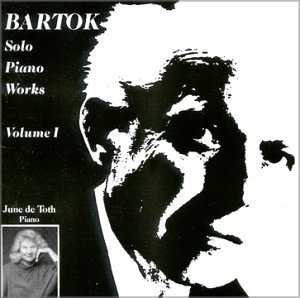Vol. I: Seven Sketches (Sz 44), Sonata 1926 (Sz 80), Fifteen Hungarian Peasant Songs and Dances (Sz 71), Four Dirges (Sz 45), Allegro Barbaro (Sz 49)
Vol. II: Suite (Sz 62), For Children (42 Hungarian Folk Songs) (Sz 42), Three Burlesques (Sz 47)
Vol. III: Six Roumanian Folk Songs (Sz 56), Ten Easy Piano Pieces (Sz 39), Fourteen Bagatelles (Sz 38), Three Rondes on Folk Tunes (Sz 84), Sonatina (Sz 55), Roumanian Dance No. 1 (Sz 43)
Vol. IV: “For Children,” 43 Slovakian Folk Songs (Sz 42), Petite Suite (Sz 105), Roumanian Christmas Carols (Sz 57)
Vol. V: Two Elegies (Sz 41), Three Hungarian Folk Songs (Sz 35), Nine Little Piano Pieces (Sz 82), Improvisations (Sz 74), Out of Doors (Sz 81)
 A composer’s works for solo piano are in many ways equivalent to a painter’s drawings: they can range from sketches to major finished works, and allow us to explore an artist’s thinking in an intimate format — a chance, quite often, to be “present at the creation.” The solo piano works of Béla Bartók are no exception. This collection, performed by Hungarian-born pianist June de Toth, is the first part of a complete issue of Bartók’s solo piano works (Vols. VI and VII, issued as a separate boxed set, contain the complete Mikrokosmos).
A composer’s works for solo piano are in many ways equivalent to a painter’s drawings: they can range from sketches to major finished works, and allow us to explore an artist’s thinking in an intimate format — a chance, quite often, to be “present at the creation.” The solo piano works of Béla Bartók are no exception. This collection, performed by Hungarian-born pianist June de Toth, is the first part of a complete issue of Bartók’s solo piano works (Vols. VI and VII, issued as a separate boxed set, contain the complete Mikrokosmos).
Bartók’s carer is very nearly a case study in the history of music in the twentieth century. He was one of the generation of composers who broke away from the romanticism of Mahler to search in new directions for sounds, structures, and concepts. Like Debussy and many others, he experimented with the pentatonic scale (although Debussy turned to the East for examples, while Bartók found his in the traditional Gypsy tunes of Hungary) and new forms, bringing these ideas back to breathe new life into old forms while maintaining his strong emphasis on the new.
This collection spans a wide range and contains works that are by turns dazzling, thoughtful, and sometimes exhausting. The Sonata 1926 is an extraordinary work, reputedly as demanding for soloists as the Liszt Sonata in B minor. It is certainly challenging to the listener, although de Toth gives no sense of strain, and indeed, sets the tone for her performance throughout: she is intelligent enough not to intrude on the music. The group For Children (42 Hungarian Folk Songs), on the other hand, really are children’s songs – one recognizes some of the melodies (another testament to the universality of children), transmitted in sophisticated but fairly transparent settings. The Six Easy Piano Pieces in Vol. III take us back to Bartók the modernist, from the very beginning showing the kind of spare, strong structure that makes his music so appealing.
That is one of the most engaging aspects of this collection: it is a detailed portrait of a composer who, like many others in the twentieth century, balanced an uncompromising modernism with a passionate devotion to traditional music, not only that of his native Hungary but of other parts of Eastern Europe as well. (One can find many like-minded artists in this period: Thomson, Copland and Ives in the United States; Villa-Lobos in Brazil; Vaughan Williams — although much more a romantic than a modernist — was equally devoted to English folk music; Bartók’s fellow Hungarian, Zoltan Kodaly; and Antonin Dvorák, whom we may consider a forerunner, who not only treasured the songs of his native Bohemia, but built a complete symphony out of traditional American music.) In Bartók’s hands, it all becomes an adventure in which we, as the audience, can hardly wait to find out what he will do next.
June de Toth renders a bravura performance, without the noise one usually associates with that word: her renditions are intelligent, sensitive, and allow the music to speak for itself. A good example is the Fourteen Bagatelles from Vol. III, in which she does not “interpret” so much as follow the music where it leads, through sometimes dizzying changes in mood, with a range of expression that is subtle, but really quite astonishing. In fact, her approach throughout avoids the kind of pyrotechnics that are all too often of great appeal to soloists, and that sometimes get in the way, but she nevertheless has a firm grasp and a deep understanding of the music, allowing Bart&*#243;k to shine through without hindrance.
All told, this is a breathtaking set. (Although honesty bids me say that five volumes – almost five and a half hours – is perhaps carrying devotion too far.) One commentator has called it “an ideal introduction to Bartók’s piano music,” which I think understates the case: this is, with the two final volumes, Bartók’s piano music. I think any single volume makes an excellent introduction to the music of the twentieth century.
(Eroica Records, 2004) [June de Toth, piano]
